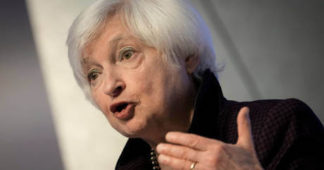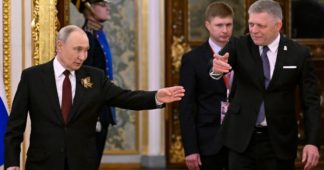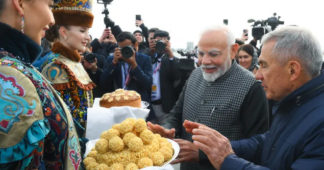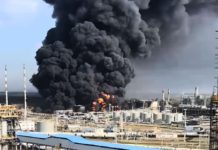By Helleniscope’s Editorial Team
Oct 22, 2025
For weeks and months, there was a palpable sense of anticipation in the atmosphere, as if a huge event was imminent: a financial bubble bursting (from real estate to A.I., there are many bubbles ready to explode), the sudden eruption of a wider war around Ukraine or Iran, or a combination of both. Today, in a dramatic afternoon announcement, U.S. Treasury Secretary Scott Bessent unveiled what he described as “one of the largest sanctions packages ever imposed on the Russian Federation.” The action directly targets Russia’s two largest oil conglomerates—Rosneft and Lukoil—along with dozens of their subsidiaries.
Bessent declared the measures were designed to force Moscow toward an “immediate cease-fire” in Ukraine, stating:
“Given President Putin’s refusal to end this senseless war, Treasury is sanctioning Russia’s two largest oil companies that fund the Kremlin’s war machine. We encourage our allies to join us.”
The announcement followed President Trump’s abrupt suspension of talks with Moscow after preliminary discussions of a potential “Budapest Summit” collapsed. Bessent indicated that sanctions would either take effect late Wednesday or Thursday morning, calling them “a substantial increase in pressure”.
The sanctions hit just as NATO Secretary-General Mark Rutte arrived in Washington for meetings with Trump, expressing hope to advance the President’s “vision of peace.” Meanwhile, Russia launched a sweeping overnight missile and drone assault across ten Ukrainian regions, damaging energy infrastructure. The imbeciles in DC and Brussels, after having mocked the Russians with fake “Minsk agreements” in 2015 and the “Instabul 2022 rejection” of an already agreed real peace plan, think that Putin and the Russian leadership will back off now… They will not. Why? Because the Russians: a) Have a 20-year lead in hypersonic missile technology, 2) Have a strategic partnership with China and Iran – meaning that their camp has many times the productive capacity of the “Combined West”, and 3) Have the support of the Global South, the overwhelming majority of humanity.
Ukrainian President Volodymyr Zelensky condemned the Russian strikes, accusing Moscow of terrorism and appealing for expanded Western air-defense systems. Russia’s Defense Ministry countered that it had targeted “energy facilities of Ukraine’s military-industrial sector” in retaliation for Ukrainian cross-border attacks.
Oil prices spiked on the sanctions news, underscoring how deeply the war and energy markets are now entwined.
STRATEGIC ANALYSIS
1. The Economic Front: Sanctions Meet Endurance
While Washington’s new sanctions appear sweeping, history suggests they are unlikely to cripple Moscow’s economy. Since 2014—and even more so since the 2022 escalation—Russia has operated under layers of Western restrictions. Yet, its GDP has continued to grow, buoyed by record oil exports to Asia, robust domestic re-industrialization, and import substitution across key sectors. According to recent IMF data, Russia’s economy expanded faster than most G7 members in both 2023 and 2024, largely because sanctions pushed it toward self-sufficiency and alternative markets rather than collapse.
Rosneft and Lukoil, although now formally blacklisted, had already rerouted much of their trade toward China, India, and the wider BRICS network, where national-currency settlements and the nascent BRICS-linked payment system are replacing dollar transactions. Thus, the immediate impact of these sanctions may be symbolic—reinforcing Western unity—but strategically limited.
2. The Emerging Eurasian Bloc
The fundamental transformation is geopolitical. The sanctions era has accelerated the consolidation of a Russia-China-Iran-BRICS strategic axis, whose combined population, resources, and manufacturing capacity now exceed those of the West by multiple measures.
-
China provides the industrial backbone and technology base.
-
Russia supplies energy, rare resources, and advanced defense technology.
-
Iran anchors the southwestern flank, linking to the Persian Gulf and serving as a logistical and drone-production hub.
-
The expanded BRICS (including Saudi Arabia, the UAE, Brazil, South Africa, and others) offers markets, alternative financial infrastructure, and diplomatic depth.
This bloc is not merely economic—it is increasingly military-technological. Joint development programs, energy pipelines, and digital-currency systems are binding these powers together in what analysts describe as a parallel order to the Western system.
3. Military and Industrial Balance: A Reversal of Eras
The sanctions and military confrontation have revealed a deeper structural problem for the West: industrial and technological lag in strategic weapons. Russia and China jointly field a generation of hypersonic glide vehicles and missile systems that Western militaries acknowledge they cannot yet reliably intercept. Their combined manufacturing capacity in key sectors—steel, shipbuilding, missiles, drones, and electronics—is several times that of the NATO bloc.
While the United States and Europe retain advanced aerospace and nuclear capabilities, the production tempo and logistics base for sustained warfare are now heavily outmatched. Western defense industries are optimized for limited interventions, not protracted high-intensity conflict, and their supply chains remain vulnerable to Asian production and critical minerals bottlenecks.
This imbalance means that if the conflict were ever to escalate into direct confrontation between blocs, the Eurasian alliance could out-produce and out-deploy the West within months—an assessment quietly echoed by several defense analysts.
4. The Nuclear Shadow
With the West economically overextended and militarily disadvantaged in conventional escalation, the unthinkable risk becomes more visible: nuclear escalation.
Each new sanction and battlefield shift increases the probability of miscalculation. The longer the war drags on without a political settlement, the greater the temptation for one side to assert deterrence through nuclear posturing. In that sense, the Treasury’s call to “stop the killing”—while moral—arrives amid a strategic environment where the ladder of escalation is already half-climbed.
CONCLUSION
The latest sanctions mark a new threshold: not just punitive measures, but the codification of a bifurcated world order. While Washington hopes to coerce Moscow through economic pressure, the Eurasian response has been to integrate, industrialize, and militarize at unprecedented speed. Far from isolating Russia, sanctions have hardened its alliances, re-engineered its economy, and pushed much of the Global South toward multipolar solidarity.
Thus, the confrontation now unfolding is not only about Ukraine—it is about which system defines the next century. And as of late 2025, the balance of endurance, production, and deterrence appears to be shifting eastward. The danger, however, is that such a shift rarely happens peacefully—and every new sanction or missile strike edges humanity closer to the point where miscalculation could trigger a catastrophe beyond measure.
.
We remind our readers that publication of articles on our site does not mean that we agree with what is written. Our policy is to publish anything which we consider of interest, so as to assist our readers in forming their opinions. Sometimes we even publish articles with which we totally disagree, since we believe it is important for our readers to be informed on as wide a spectrum of views as possible.











